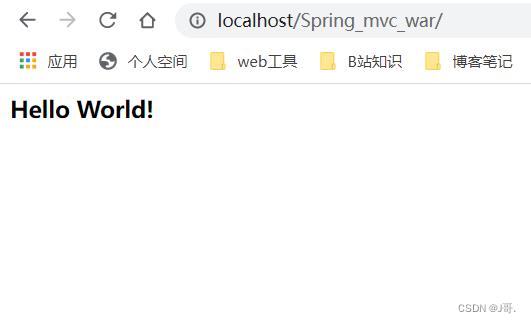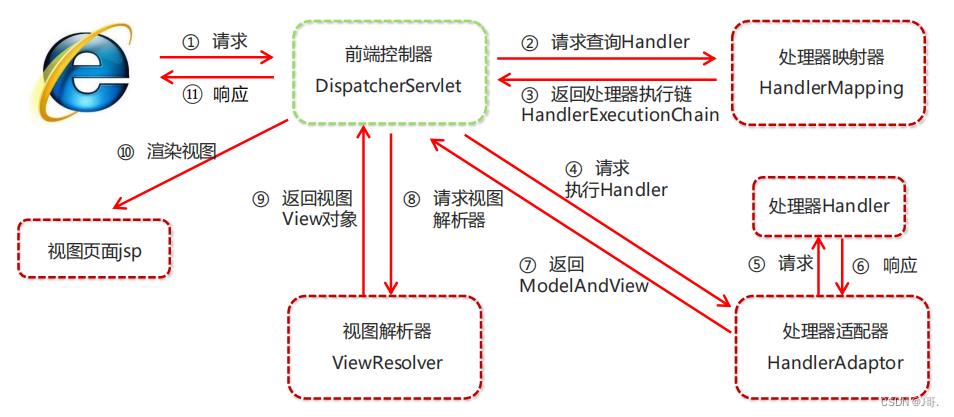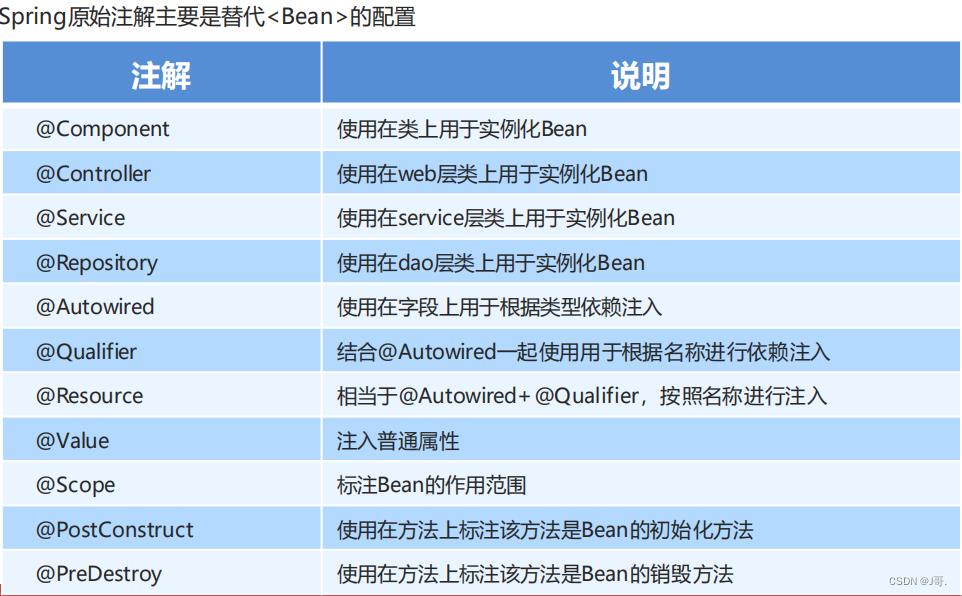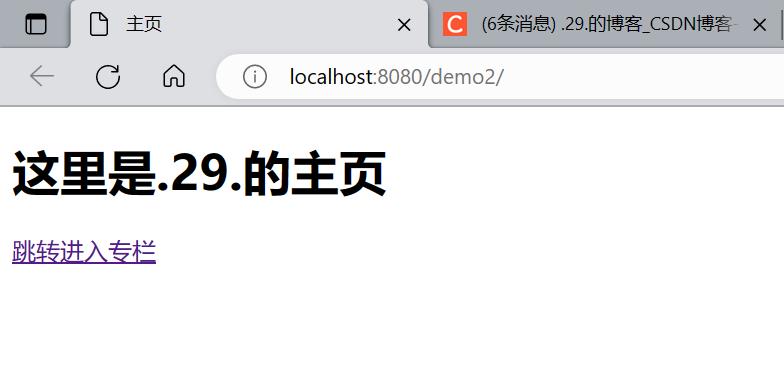SpringMVC 一文掌握 》》》 @RequestMapping注解
Posted .29.
tags:
篇首语:本文由小常识网(cha138.com)小编为大家整理,主要介绍了SpringMVC 一文掌握 》》》 @RequestMapping注解相关的知识,希望对你有一定的参考价值。

个人简介:Java领域新星创作者;阿里云技术博主、星级博主、专家博主;正在Java学习的路上摸爬滚打,记录学习的过程~
个人主页:.29.的博客
学习社区:进去逛一逛~

@RequestMapping注解
- 一、SpringMVC环境准备
- 二、 @RequestMapping注解 功能
- 三、@RequestMapping注解 位置说明
- 四、@RequestMapping注解 属性
- 五、ant风格的路径
- 六、路径中占位符的使用
一、SpringMVC环境准备
1.相关Maven依赖:
<dependencies>
<!-- SpringMVC -->
<dependency>
<groupId>org.springframework</groupId>
<artifactId>spring-webmvc</artifactId>
<version>5.3.1</version>
</dependency>
<!-- 日志 -->
<dependency>
<groupId>ch.qos.logback</groupId>
<artifactId>logback-classic</artifactId>
<version>1.2.3</version>
</dependency>
<!-- ServletAPI -->
<dependency>
<groupId>javax.servlet</groupId>
<artifactId>javax.servlet-api</artifactId>
<version>3.1.0</version>
<scope>provided</scope>
</dependency>
<!-- Spring5和Thymeleaf整合包 -->
<dependency>
<groupId>org.thymeleaf</groupId>
<artifactId>thymeleaf-spring5</artifactId>
<version>3.0.12.RELEASE</version>
</dependency>
</dependencies>
同时记得将打包方式改为war包(web工程需要的方式):👇👇👇

2.配置web.xml文件:
首先在main包下创建webapp:
项目结构中创建web.xml配置文件:
(这里创建时需要注意目录是否正确 – src\\main\\webapp\\WEB-INF\\web.xml)
配置web.xml文件:
<?xml version="1.0" encoding="UTF-8"?>
<web-app xmlns="http://xmlns.jcp.org/xml/ns/javaee"
xmlns:xsi="http://www.w3.org/2001/XMLSchema-instance"
xsi:schemaLocation="http://xmlns.jcp.org/xml/ns/javaee http://xmlns.jcp.org/xml/ns/javaee/web-app_4_0.xsd"
version="4.0">
<!-- 配置SpringMVC的前端控制器,对浏览器发送的请求统一进行处理 -->
<servlet>
<servlet-name>springMVC</servlet-name>
<servlet-class>org.springframework.web.servlet.DispatcherServlet</servlet-class>
<!-- 通过初始化参数指定SpringMVC配置文件的位置和名称 -->
<init-param>
<!-- contextConfigLocation为固定值 -->
<param-name>contextConfigLocation</param-name>
<!-- 使用classpath:表示从类路径查找配置文件,例如maven工程中的src/main/resources -->
<param-value>classpath:springMVC.xml</param-value>
</init-param>
<!--
作为框架的核心组件,在启动过程中有大量的初始化操作要做
而这些操作放在第一次请求时才执行会严重影响访问速度
因此需要通过此标签将启动控制DispatcherServlet的初始化时间提前到服务器启动时
-->
<load-on-startup>1</load-on-startup>
</servlet>
<servlet-mapping>
<servlet-name>springMVC</servlet-name>
<!--
设置springMVC的核心控制器所能处理的请求的请求路径
/所匹配的请求可以是/login或.html或.js或.css方式的请求路径
但是/不能匹配.jsp请求路径的请求
/*则可以匹配所有方式的请求路径
-->
<url-pattern>/</url-pattern>
</servlet-mapping>
</web-app>
3.创建请求控制器:
由于前端控制器对浏览器发送的请求进行了统一的处理,但是具体的请求有不同的处理过程,因此需要创建处理具体请求的类,即请求控制器
请求控制器中每一个处理请求的方法成为控制器方法
因为SpringMVC的控制器由一个POJO(普通的Java类)担任,因此需要通过@Controller注解将其标识为一个控制层组件,交给Spring的IoC容器管理,此时SpringMVC才能够识别控制器的存在
import org.springframework.stereotype.Controller;
/**
* @author .29.
* @create 2023-03-04 17:17
*/
@Controller
public class RequestMappingController
4.创建SpringMVC的XML配置文件:
👇
XML配置文件内容:
<?xml version="1.0" encoding="UTF-8"?>
<beans xmlns="http://www.springframework.org/schema/beans"
xmlns:xsi="http://www.w3.org/2001/XMLSchema-instance"
xmlns:context="http://www.springframework.org/schema/context"
xsi:schemaLocation="http://www.springframework.org/schema/beans http://www.springframework.org/schema/beans/spring-beans.xsd http://www.springframework.org/schema/context https://www.springframework.org/schema/context/spring-context.xsd">
<!--配置自动扫描的包-->
<context:component-scan base-package="com.haojin.java.controller"/>
<!-- 配置Thymeleaf视图解析器 -->
<bean id="viewResolver" class="org.thymeleaf.spring5.view.ThymeleafViewResolver">
<property name="order" value="1"/>
<property name="characterEncoding" value="UTF-8"/>
<property name="templateEngine">
<bean class="org.thymeleaf.spring5.SpringTemplateEngine">
<property name="templateResolver">
<bean class="org.thymeleaf.spring5.templateresolver.SpringResourceTemplateResolver">
<!-- 视图前缀 -->
<property name="prefix" value="/WEB-INF/templates/"/>
<!-- 视图后缀 -->
<property name="suffix" value=".html"/>
<property name="templateMode" value="HTML5"/>
<property name="characterEncoding" value="UTF-8" />
</bean>
</property>
</bean>
</property>
</bean>
</beans>
二、 @RequestMapping注解 功能
从注解名称上我们可以看到,@RequestMapping注解的作用就是将请求和处理请求的控制器方法关联起来,建立映射关系。
SpringMVC 接收到指定的请求,就会来找到在映射关系中对应的控制器方法来处理这个请求。
功能案例
实现对index.html页面的访问 + 通过超链接跳转指定页面:
1.index.html页面:
<!DOCTYPE html>
<html lang="en" xmlns:th="http://www.thymeleaf.org">
<head>
<meta charset="UTF-8">
<title>主页</title>
</head>
<body>
<h1>这里是.29.的主页</h1>
<!--Thymeleaf视图模板技术处理绝对路径链接,自动添加上下文-->
<a th:href="@/target">跳转进入专栏</a>
</body>
</html>
2.指定页面target.html:
<!DOCTYPE html>
<html lang="en" xmlns:th="http://www.thymeleaf.org">
<head>
<meta charset="UTF-8">
<title>专栏</title>
</head>
<body>
<h1>这里是SpringMVC专栏</h1>
</body>
</html>
3.请求控制器中创建处理请求的方法:
- @RequestMapping注解:处理请求和控制器方法之间的映射关系
- @RequestMapping注解的value属性可以通过请求地址匹配请求,/表示的当前工程的上下文路径
- localhost:8080/springMVC/
import org.springframework.stereotype.Controller;
import org.springframework.web.bind.annotation.RequestMapping;
/**
* @author .29.
* @create 2023-03-04 16:07
*/
@Controller
public class testController
@RequestMapping(value = "/")
public String index()
return "index";
@RequestMapping(value="/target")
public String target()
return "target";
4.效果:
👇
功能小结
浏览器发送请求,若请求地址符合前端控制器的url-pattern,该请求就会被前端控制器DispatcherServlet处理。前端控制器会读取SpringMVC的核心配置文件,通过扫描组件找到控制器,将请求地址和控制器中@RequestMapping注解的value属性值进行匹配,若匹配成功,该注解所标识的控制器方法就是处理请求的方法。处理请求的方法需要返回一个字符串类型的视图名称,该视图名称会被视图解析器解析,加上前缀和后缀组成视图的路径,通过Thymeleaf对视图进行渲染,最终转发到视图所对应页面
三、@RequestMapping注解 位置说明
-
@RequestMapping标识一个类:设置映射请求的请求路径的初始信息
-
@RequestMapping标识一个方法:设置映射请求请求路径的具体信息
当我们同时使用@RequestMapping标识请求控制类和其中的请求方法,但是请求路径只设置了具体信息,而不包含初始信息时,就会出现找不到资源的错误。
请求控制类:
import org.springframework.stereotype.Controller;
import org.springframework.web.bind.annotation.RequestMapping;
import org.springframework.web.bind.annotation.RequestMethod;
/**
* @author .29.
* @create 2023-03-04 17:17
*/
@Controller
@RequestMapping(value = "/one") //在类上标识@RequestMapping注解
public class RequestMappingController
//当前请求路径应当是:/one/testRequestMapping
@RequestMapping(value = "/testRequestMapping")
public String success()
return "success";
访问的主页面:
<!DOCTYPE html>
<html lang="en" xmlns:th="http://www.thymeleaf.org">
<head>
<meta charset="UTF-8">
<title>主页</title>
</head>
<body>
<h1>这里是.29.的主页</h1>
<a th:href="@/target">跳转进入专栏(测试@RequestMapping 功能)</a> <br>
<a th:href="@/testRequestMapping">测试@RequestMapping 标识位置</a> <br>
</body>
</html>
就会发现找不到对应资源:
四、@RequestMapping注解 属性
⚪value属性
-
@RequestMapping注解的value属性通过请求的请求地址 匹配请求映射;
-
@RequestMapping注解的value属性是一个字符串类型的数组,表示该请求映射能够匹配多个请求地址所对应的请求;
-
@RequestMapping注解的value属性必须设置,至少通过请求地址匹配请求映射;
import org.springframework.stereotype.Controller;
import org.springframework.web.bind.annotation.RequestMapping;
import org.springframework.web.bind.annotation.RequestMethod;
/**
* @author .29.
* @create 2023-03-04 17:17
*/
@Controller
@RequestMapping(value = "/one") //在类上标识@RequestMapping注解
public class RequestMappingController
//当前请求路径应当是:/one/testRequestMapping
@RequestMapping(value = "/testRequestMapping")
public String success()
return "success";
//value属性可以匹配多个请求地址所对应的请求,其中一个请求路径映射匹配即可
@RequestMapping(
value = "/test","/test2","test3",
)
public String success2()
return "success";
<!DOCTYPE html>
<html lang="en" xmlns:th="http://www.thymeleaf.org">
<head>
<meta charset="UTF-8">
<title>主页</title>
</head>
<body>
<h1>这里是.29.的主页</h1>
<a th:href="@/target">跳转进入专栏(测试@RequestMapping 功能)</a> <br>
<a th:href="@/one/testRequestMapping">测试@RequestMapping 标识位置</a> <br>
<a th:href="@/one/test">测试@RequestMapping value属性</a> <br>
</body>
</html>
⚪method属性
-
@RequestMapping注解的method属性通过请求的请求方式(get或post)匹配请求映射;
-
@RequestMapping注解的method属性是一个RequestMethod类型的数组,表示该请求映射能够匹配多种请求方式的请求;
-
若当前请求的请求地址满足请求映射的value属性,但是请求方式不满足method属性,则浏览器报错405:Request method ‘POST’ not supported
使用方式:
@RequestMapping(
value = "请求路径1",
method = RequestMethod.GET
)
@RequestMapping(
value = "请求路径1","请求路径2",
method = RequestMethod.GET,RequestMethod.POST
)
注意:
1、对于处理指定请求方式的控制器方法,SpringMVC中提供了@RequestMapping的派生注解
处理get请求的映射–>@GetMapping
处理post请求的映射–>@PostMapping
处理put请求的映射–>@PutMapping
处理delete请求的映射–>@DeleteMapping
2、常用的请求方式有get,post,put,delete
但是目前浏览器只支持get和post,若在form表单提交时,为method设置了其他请求方式的字符串(put或delete),则按照默认的请求方式get处理
⚪params属性
-
@RequestMapping注解的params属性通过请求的请求参数匹配请求映射
-
@RequestMapping注解的params属性是一个字符串类型的数组,可以通过四种表达式设置请求参数和请求映射的匹配关系
-
若当前请求满足@RequestMapping注解的value和method属性,但是不满足params属性,此时页面会报 错误400
使用方式:
“param”:要求请求映射所匹配的请求必须携带param请求参数
“!param”:要求请求映射所匹配的请求必须不能携带param请求参数
“param=value”:要求请求映射所匹配的请求必须携带param请求参数且param=value
“param!=value”:要求请求映射所匹配的请求必须携带param请求参数但是param!=value
@RequestMapping(
value = "请求路径1", "请求路径2",
params = "username","!sex","age=18","password!=123456"
)
注:html页面中路径携带的参数,使用()括起来:
<a th:href="@/test(username='admin',password=123,age=18)">测试@RequestMapping的params属性-->/test</a>
⚪headers属性
-
@RequestMapping注解的headers属性通过请求的请求头信息匹配请求映射
-
@RequestMapping注解的headers属性是一个字符串类型的数组,可以通过四种表达式设置请求头信息和请求映射的匹配关系
-
若当前请求满足@RequestMapping注解的value和method属性,但是不满足headers属性,此时页面显示404错误,即资源未找到
使用方式:
“header”:要求请求映射所匹配的请求必须携带header请求头信息
“!header”:要求请求映射所匹配的请求必须不能携带header请求头信息
“header=value”:要求请求映射所匹配的请求必须携带header请求头信息且header=value
“header!=value”:要求请求映射所匹配的请求必须携带header请求头信息且header!=value
请求头信息是用Map集合存储的,不知道请求头包含什么信息的可以浏览器搜索一下。
五、ant风格的路径
SpringMVC支持的ant风格路径 使用方式:
-
?:这里表示任意的单个字符; -
*:表示任意的0个或多个字符; -
**:表示任意的一层或多层目录;
注意:在使用**时,只能使用/**/xxx的方式;
@RequestMapping("/a?a/test")
@RequestMapping("/a*a/test")
@RequestMapping("/**/test")
六、路径中占位符的使用
SpringMVC路径中的占位符常用于RESTful风格中,当请求路径中将某些数据通过路径的方式传输到服务器中,就可以在相应的@RequestMapping注解的value属性中通过占位符xxx表示传输的数据,在通过@PathVariable注解,将占位符所表示的数据赋值给控制器方法的形参。
使用方式:
xxx表示传输的数据,在通过@PathVariable注解,将占位符所表示的数据赋值给控制器方法的形参
@RequestMapping("/testRest/name/sex/age")
public String testRest(@PathVariable("name") String name, 一、Spring MVC入门
1.1 Web环境集成
- 配置ContextLoaderListener监听器
- 使用WebApplicationContextUtils获得应用上下文
1.1.1 导入Spring集成web的坐标
<dependency>
<groupId>org.springframework</groupId>
<artifactId>spring-web</artifactId>
<version>5.0.5.RELEASE</version>
</dependency>
1.1.2 Spring提供获取应用上下文的工具
在web.xml中配置ContextLoaderListener监听器(导入spring-web坐标) – 1.1.1
使用WebApplicationContextUtils获得应用上下文对象ApplicationContext
- web.xml
<!-- 全局参数 这个没啥用 -->
<context-param>
<param-name>contextConfigLocation</param-name>
<param-value>classpath:applicationContext.xml</param-value>
</context-param>
<!--Spring的监听器-->
<listener>
<listener-class>
org.springframework.web.context.ContextLoaderListener
</listener-class>
</listener>
- 通过工具获得应用上下文对象 在 servlet层代码中
ApplicationContext applicationContext = WebApplicationContextUtils.getWebApplicationContext(servletContext);
Object obj = applicationContext.getBean("id");
1.2 MVC简介
-
SpringMVC 是一种基于 Java 的实现 MVC 设计模型的请求驱动类型的轻量级 Web 框架,属于SpringFrameWork 的后续产品,已经融合在 Spring Web Flow 中。
-
SpringMVC 已经成为目前最主流的MVC框架之一,并且随着Spring3.0 的发布,全面超越 Struts2,成为最优秀的 MVC 框架。它通过一套注解,让一个简单的 Java 类成为处理请求的控制器,而无须实现任何接口。同时它还支持 RESTful 编程风格的请求。
- Spring MVC开发步骤
- 导入SpringMVC相关坐标
- 配置SpringMVC核心控制器DispathcerServlet
- 创建Controller类和视图页面
- 使用注解配置Controller类中业务方法的映射地址
- 配置SpringMVC核心文件 spring-mvc.xml
- 客户端发起请求测试
1.2.1 导入Spring和SpringMVC的坐标
<dependencies>
<dependency>
<groupId>junit</groupId>
<artifactId>junit</artifactId>
<version>4.11</version>
<scope>test</scope>
</dependency>
<dependency>
<groupId>org.springframework</groupId>
<artifactId>spring-web</artifactId>
<version>5.0.5.RELEASE</version>
</dependency>
<!--Spring坐标-->
<dependency>
<groupId>org.springframework</groupId>
<artifactId>spring-context</artifactId>
<version>5.0.5.RELEASE</version>
</dependency>
<!--SpringMVC坐标-->
<dependency>
<groupId>org.springframework</groupId>
<artifactId>spring-webmvc</artifactId>
<version>5.0.5.RELEASE</version>
</dependency>
<!--Servlet坐标-->
<dependency>
<groupId>javax.servlet</groupId>
<artifactId>servlet-api</artifactId>
<version>2.5</version>
</dependency>
<!--Jsp坐标-->
<dependency>
<groupId>javax.servlet.jsp</groupId>
<artifactId>jsp-api</artifactId>
<version>2.0</version>
</dependency>
<dependency>
<groupId>mysql</groupId>
<artifactId>mysql-connector-java</artifactId>
<version>5.1.32</version>
</dependency>
<dependency>
<groupId>com.alibaba</groupId>
<artifactId>druid</artifactId>
<version>1.1.10</version>
</dependency>
<!-- spring-test -->
<dependency>
<groupId>org.springframework</groupId>
<artifactId>spring-test</artifactId>
<version>5.2.10.RELEASE</version>
<scope>test</scope>
</dependency>
<!-- mybatis-spring -->
<dependency>
<groupId>org.mybatis</groupId>
<artifactId>mybatis-spring</artifactId>
<version>1.3.2</version>
</dependency>
</dependencies>
1.2.2 配置SpringMVC核心控制器DispathcerServlet
<!-- 在web.xml配置SpringMVC的核心控制器 -->
<!DOCTYPE web-app PUBLIC
"-//Sun Microsystems, Inc.//DTD Web Application 2.3//EN"
"http://java.sun.com/dtd/web-app_2_3.dtd" >
<web-app xmlns="http://xmlns.jcp.org/xml/ns/javaee"
xmlns:xsi="http://www.w3.org/2001/XMLSchema-instance"
xsi:schemaLocation="http://xmlns.jcp.org/xml/ns/javaee http://xmlns.jcp.org/xml/ns/javaee/web-app_4_0.xsd"
version="4.0">
<display-name>Archetype Created Web Application</display-name>
<!-- 配置SpringMVC前端控制权 -->
<servlet>
<servlet-name>DispatcherServlet</servlet-name>
<servlet-class>org.springframework.web.servlet.DispatcherServlet</servlet-class>
<init-param>
<param-name>contextConfigLocation</param-name>
<param-value>classpath:spring-mvc.xml</param-value>
</init-param>
<load-on-startup>1</load-on-startup> <!--服务器启动就加载该配置-->
</servlet>
<servlet-mapping>
<servlet-name>DispatcherServlet</servlet-name>
<url-pattern>/</url-pattern> <!-- 任何请求都走这个控制器 -->
</servlet-mapping>
<!-- 全局初始化参数 -->
<context-param>
<param-name>contextConfigLocation</param-name>
<param-value>classpath:applicationContext.xml</param-value>
</context-param>
<!-- 配置监听器 加载配置文件 -->
<listener>
<listener-class>org.springframework.web.context.ContextLoaderListener</listener-class>
</listener>
</web-app>
1.2.3 创建Controller和业务方法 并 创建视图页面index.jsp
package com.web.servlet;
import org.springframework.stereotype.Controller;
import org.springframework.web.bind.annotation.RequestMapping;
/**
* @author: Laity
* @Project: JavaLaity
* @Package: com.web.servlet.UserController
* @Date: 2022年05月27日 14:35
* @Description: web层
*/
@Controller // 放到容器中
public class UserController
@RequestMapping("/quick") // 设置路由
public String save()
System.out.println("Controller save running...");
return "success.jsp"; // 跳转路由

1.2.4 配置注解
- 1.2.3
1.2.5 创建spring-mvc.xml
<?xml version="1.0" encoding="UTF-8"?>
<beans xmlns="http://www.springframework.org/schema/beans"
xmlns:xsi="http://www.w3.org/2001/XMLSchema-instance"
xmlns:context="http://www.springframework.org/schema/context"
xsi:schemaLocation="http://www.springframework.org/schema/beans http://www.springframework.org/schema/beans/spring-beans.xsd
http://www.springframework.org/schema/context http://www.springframework.org/schema/context/spring-context.xsd">
<!-- Controllers 的组件扫描 -->
<context:component-scan base-package="com.web"/>
</beans>
1.2.6 访问测试地址


1.3 MVC组件解析
1.3.1 SpringMVC的执行流程
1、用户发送请求至前端控制器DispatcherServlet(前端控制器)。
2、DispatcherServlet收到请求调用HandlerMapping处理器映射器。
3、处理器映射器找到具体的处理器(可以根据xml配置、注解进行查找),生成处理器对象及处理器拦截器(如果有则生成)一并返回给DispatcherServlet。
4、DispatcherServlet调用HandlerAdapter(处理器映射器)处理器适配器。
5、HandlerAdapter经过适配调用具体的处理器(Controller,也叫后端控制器)。
6、Controller执行完成返回ModelAndView。
7、HandlerAdapter将controller执行结果ModelAndView返回给DispatcherServlet。
8、DispatcherServlet将ModelAndView传给ViewReslover视图解析器。
9、ViewReslover解析后返回具体View。
10、DispatcherServlet根据View进行渲染视图(即将模型数据填充至视图中)。DispatcherServlet响应用户。

1.3.2 SpringMVC组件解析
1. 前端控制器:DispatcherServlet
用户请求到达前端控制器,它就相当于 MVC 模式中的 C,DispatcherServlet 是整个流程控制的中心,由它调用其它组件处理用户的请求,DispatcherServlet 的存在降低了组件之间的耦合性。
2. 处理器映射器:HandlerMapping
HandlerMapping 负责根据用户请求找到 Handler 即处理器,SpringMVC 提供了不同的映射器实现不同的映射方式,例如:配置文件方式,实现接口方式,注解方式等。
3. 处理器适配器:HandlerAdapter
通过 HandlerAdapter 对处理器进行执行,这是适配器模式的应用,通过扩展适配器可以对更多类型的处理器进行执行。
4. 处理器:Handler
它就是我们开发中要编写的具体业务控制器。由 DispatcherServlet 把用户请求转发到 Handler。由Handler 对具体的用户请求进行处理。
5. 视图解析器:View Resolver
View Resolver 负责将处理结果生成 View 视图,View Resolver 首先根据逻辑视图名解析成物理视图名,即具体的页面地址,再生成 View 视图对象,最后对 View 进行渲染将处理结果通过页面展示给用户。
6. 视图:View
SpringMVC 框架提供了很多的 View 视图类型的支持,包括:jstlView、freemarkerView、pdfView等。最常用的视图就是 jsp。一般情况下需要通过页面标签或页面模版技术将模型数据通过页面展示给用户,需要由程序员根据业务需求开发具体的页面.
1.3.3 SpringMVC注解解析
- 原始注解

- 新注解
注解 说明 @Configuration 用于指定当前类是一个 Spring 配置类,当创建容器时会从该类上加载注解 @ComponentScan 用于指定Spring在初始化容器时要扫描的包。作用和在 Spring 的 xml 配置文件中的<context:component-scan base-package=“com.itheima”/>一样 @Bean 使用在方法上,标注将该方法的返回值存储到 Spring 容器中 @PropertySource 用于加载.properties 文件中的配置 @Import 用于导入其他配置类
- Spring MVC注解
@RequestMapping
作用:用于建立请求 URL 和处理请求方法之间的对应关系,设置路由
位置:
-
类上,请求URL 的第一级访问目录。此处不写的话,就相当于应用的根目录
-
方法上,请求 URL 的第二级访问目录,与类上的使用@ReqquestMapping标注的一级目录一起组成访问虚拟路径
属性:
-
value:用于指定请求的URL。它和path属性的作用是一样的(设置路由)
-
method:用于指定请求的方式(RequestMethed.POST/GET)
-
params:用于指定限制请求参数的条件。它支持简单的表达式。要求请求参数的key和value必须和配置的一模一样
例如:
-
params = “accountName”,表示请求参数必须有accountName
-
params = “moeny!100”,表示请求参数中money不能是100
1. mvc命名空间引入
命名空间:xmlns:context=“http://www.springframework.org/schema/context”
xmlns:mvc=“http://www.springframework.org/schema/mvc”
约束地址:http://www.springframework.org/schema/context
http://www.springframework.org/schema/context/spring-context.xsd
http://www.springframework.org/schema/mvc
http://www.springframework.org/schema/mvc/spring-mvc.xsd
2. 组件扫描
SpringMVC基于Spring容器,所以在进行SpringMVC操作时,需要将Controller存储到Spring容器中,如果使
用@Controller注解标注的话,就需要使用<context:component-scan base-package=“com.itheima.controller"/>进行组件扫描。
1.3.4 SpringMVC的XML配置解析
SpringMVC有默认组件配置,默认组件都是DispatcherServlet.properties配置文件中配置的,该配置文件地址org/springframework/web/servlet/DispatcherServlet.properties,该文件中配置了默认的视图解析器1.3.5 知识总结
<!-- spring-mvc.xml中配置 前缀和后缀 个人感觉用处不大 -->
<!-- 手动配置内部资源视图解析器 -->
<bean id="viewResolver" class="org.springframework.web.servlet.view.InternalResourceViewResolver">
<property name="prefix" value="/jsp/"></property>
<property name="suffix" value=".jsp"></property>
</bean>
@Controller // 放到容器中
@RequestMapping("/user")
public class UserController
@RequestMapping(value = "/quick", method = RequestMethod.GET, params = "username") // 设置路由
public String save()
System.out.println("Controller save running...");
return "success";
// 访问 http:localhost/user/quick?username=xxx ==> 访问的是 /jsp/success.jsp 文件
二、Spring MVC数据响应
2.1 Spring MVC的数据响应
2.1.1 SpringMVC的数据响应方式
2.1.1.1 页面跳转
-
直接返回字符串
-
此种方式会将返回的字符串与视图解析器的前后缀拼接后跳转。
-
<!-- spring-mvc.xml中配置 前缀和后缀 个人感觉用处不大 -->
<!-- 手动配置内部资源视图解析器 -->
<bean id="viewResolver" class="org.springframework.web.servlet.view.InternalResourceViewResolver">
<property name="prefix" value="/jsp/"></property>
<property name="suffix" value=".jsp"></property>
</bean>
-
@Controller // 放到容器中
@RequestMapping("/user")
public class UserController
@RequestMapping(value = "/quick", method = RequestMethod.GET, params = "username") // 设置路由
public String save()
System.out.println("Controller save running...");
return "success";
// 访问 http:localhost/user/quick?username=xxx ==> 访问的是 /jsp/success.jsp 文件
-
通过ModelAndView对象返回
-
第一种
-
<%@ page contentType="text/html;charset=UTF-8" language="java" %>
<%@ page language="java" pageEncoding="utf-8" isELIgnored="false" %>
<html>
<head>
<title>Title</title>
</head>
<body>
<h1> success $username </h1>
</body>
</html>
-
@RequestMapping(value = "/quick2") // 设置路由
public ModelAndView save2()
/**
* model :模型 用于封装数据
* view :视图 用于展示数据
*/
ModelAndView Mv = new ModelAndView();
// 设置模型数据
Mv.addObject("username", "laity");
// 设置视图
Mv.setViewName("success");
return Mv;
-
第二种
-
/**
* spring mvc 可以 注入ModelAndView
*
* @param Mv
* @return
*/
@RequestMapping(value = "/quick3") // 设置路由
public ModelAndView save3(ModelAndView Mv)
Mv.addObject("username", "Jge");
Mv.setViewName("success");
return Mv;
-
@RequestMapping(value = "/quick4") // 设置路由
public String save4(Model model)
model.addAttribute("username", "呼啦啦");
return "success";
-
@RequestMapping(value = "/quick5") // 设置路由
public String save5(Model model, HttpServletRequest request, HttpServletResponse response)
request.setAttribute("username", "quick5");
return "success"; // 访问 http://localhost/user/quick5 一样返回数据
2.1.1.2 回写数据
-
直接返回字符串
-
Web基础阶段,客户端访问服务器端,如果想直接回写字符串作为响应体返回的话,只需要使用response.getWriter().print(“hello world”) 即可。
-
@RequestMapping(value = "/quick6") // 设置路由
public void save6(Model model, HttpServletRequest request, HttpServletResponse response) throws Exception
response.getWriter().print("hello world");
// 访问 http://localhost/user/quick6 页面展示 hello world
-
那么Controller中怎样向request域中存储数据呢?
将需要回写的字符串直接返回,但此时需要通过**@ResponseBody**注解告知SpringMVC框架,方法返回的字符串不是跳转是直接在http响应体中返回。
-
@RequestMapping(value = "/quick7") // 设置路由
@ResponseBody // 告诉mvc框架该方法不进行视图跳转
public String save7()
return "hello world";
-
开发中往往要将复杂的java对象转换成json格式的字符串,我们可以使用web阶段学习过的json转换工具jackson进行转换,导入jackson坐标
-
<!--jackson-->
<dependency






